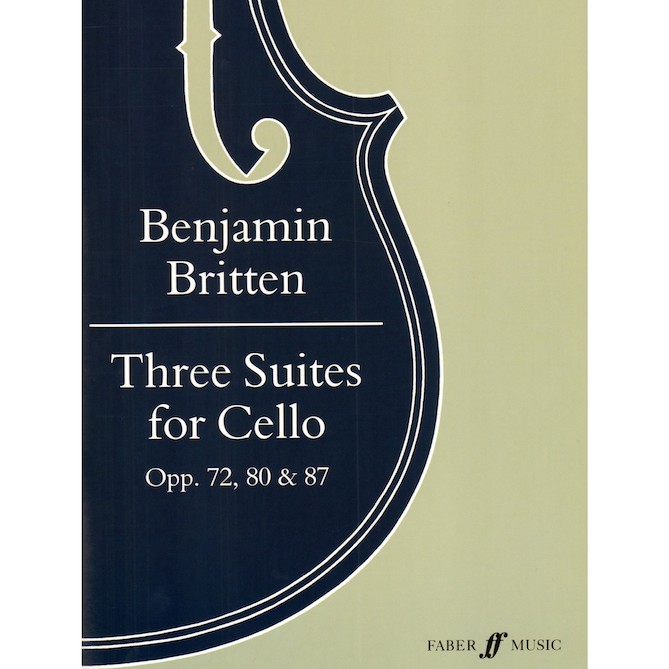
The Britten Cello Suites (Part 1)
Aron Zelkowicz
Cellists have as much reason as anyone to celebrate the upcoming Benjamin Britten centenary, if not more so. The five major cello works he wrote for Mstislav Rostropovich – the sonata, the Symphony Concerto, and the three solo suites – have been taken up in short order as standard repertoire. By my unofficial count there are twenty recordings of the complete cello suites on the market, not to mention sixteen “incomplete” cycles of one or two suites here and there.
So it can be easy to forget that this music hasn’t been around for very long. Those of us of a certain age can remember relics like the individually published suites, each score with its distinctly colored cover. Or Rostropovich’s classic 1970 LP titled, rather definitively, “Britten: The Suites for Cello” – which included the only two suites written up to that point.
Britten wrote the Third Suite over the course of nine days in 1971, but the genius of that work would take a bit longer to achieve mainstream recognition (probably due to Slava’s three-year delay of the premiere and then reluctance to commit it to disc). I remember playing the Third for several professors in my college years (in the nineties), who confessed to hearing it back then for the first time. No longer.
One of my teachers, Janos Starker, stayed clear of much of the Rostropovich repertoire, although he knew the major Shostakovich and Prokofiev concertos inside out. He somewhat dismissively described the Slava-Britten collaborations as conceived with a bottle of vodka “when it was this full” (holding one hand, palm down, high over the other) and ending when the bottle was “this full” (lowering the top hand significantly). He conceded, though, that the suites were effective if one really made a show of them.
To this point, even a non-Brittenite like Starker was on the money. Britten couldn’t help but bring his theatrical flair to otherwise abstract music. The man who knew how to pace a two and a half hour opera with orchestral interludes, huge choruses, intimate monologues, comic relief, and cliffhanger intermission-raisers knew how to pace an instrumental suite. To pull it off, the performer must indulge in the dramatic silences, the all-fingers-on-deck pizzicati, the folk elements, and the distinct personality of each suite. And, unfortunately, performing them from memory helps a lot.
There have been so many compelling interpreters of one or all of the suites that I thought a fitting tribute and reexamination of these works would be to compile some of their insights, along with a few of my own thoughts, as we approach the big 1-0-0. These musings will be delivered in multiple installments, with each blog focusing on one suite.
First up, the famous First Suite (known, like Rocky or Iron Man, once upon a time as simply “Suite”, before the sequels).
* * * * * * *
“I just loved the Third Canto.” It would have been easy to take this expression of appreciation for granted from an aficionado. But the thirty-something man in the business suit seemed to be a casual fan of classical music, having found my recital on Eventbrite after seeing the attractive photos of the Baroque Room in St. Paul, Minnesota (“I didn’t believe we would actually sit so close to the performers!”).
Granted, the movements were listed in the program, and a spoken introduction goes a long way to help an audience traverse Britten’s parade of character pieces: from a snaky Fuga to an impassioned Lamento to a Japanese-sounding Serenata to a Stravinsky-esque Marcia to a creepy Bordone to a breathless Moto Perpetuo.
But I suspect a first-time listener could still get lost navigating a twenty-five minute, uninterrupted work for solo cello. Britten’s genius doesn’t allow this to happen. The opening Canto Primo is so identifiable that anyone can immediately recognize its fingerprint beneath the added dissonances of the second and third Cantos, its falling sixth acting as the perfect Greek chorus to intermittently comment on the surrounding movements. When the grandiose fourth Canto returns in the finale, it is like a familiar friend who makes a heroic appearance before being quickly infected by the virus of sixteenth notes. Like something from a science fiction movie, the character is transformed into a hybrid Canto and Moto Perpetuo creature as the two ideas meld into one. This conflict is overtaken by another pitched battle between the G Major and D Major keys implied in the First Canto’s opening chords. It ends, most democratically and audaciously, with a dead-even tie. Unlike the more conservative neo-baroque suites of Bloch and Reger, Britten has no qualms about ending the work on a clashing dissonance (F-sharp and G).
Rather than let the whole piece wash over him, I was amazed that this listener could follow the narrative progression of a non-verbal drama on first hearing…and thanked him for his attention!
Watch Aron perform Britten’s first cello suite.
Next up: An American cellist plays the First Suite to an audience of children, with the help of a bullfrog.
Subjects: Repertoire
Tags: 1971, Aron, Benjamin Britten, Britten solo cello suites, canto, cello, cellobello, centenary, compelling interpreters, effect, Effective, genius, grandiose, indulge, Janos Starker, memory, movements, Mstislav Rostropovich, navigation, non-verbal drama, opera, Performing, personality, pizzicati, silences, solo cello suites, solo suites, Suites, Zelkowicz
